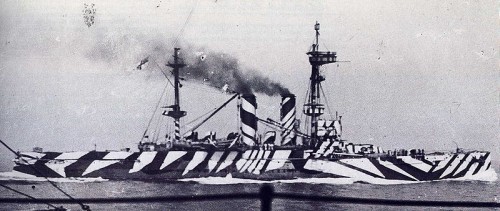 During World War I, the navies of the world experimented with dazzle camouflage. The odd angular shapes and lines, such as those seen on the British minelayer pictured above, broke up the visual patterns of the vessels, making them harder to see at a distance. Now researchers at the University of Bristol (UK) think that it could still be useful for land vehicles on modern battlefields:
During World War I, the navies of the world experimented with dazzle camouflage. The odd angular shapes and lines, such as those seen on the British minelayer pictured above, broke up the visual patterns of the vessels, making them harder to see at a distance. Now researchers at the University of Bristol (UK) think that it could still be useful for land vehicles on modern battlefields:
High-contrast dazzle camouflage could throw off an attacker’s perception of a target’s speed by a wide enough margin to cause a miss, the researchers said. “In a typical situation involving an (rocket-propelled grenade) attack on a Land Rover, the reduction in perceived speed would be sufficient to make the grenade miss where it was aimed by about a meter (3.3 feet), which could be the difference between survival or otherwise for the occupants of the vehicle,” said Nick Scott-Samuel of the University of Bristol.
They arrived at this conclusion by examining the ability of people to perceive the speeds of objects covered variously by dazzle and conventional camouflage patterns. Participants experienced a 7% greater difficulty gauging the speed of the dazzle-covered objects -- which could be enough to save the lives of a significant number of soldiers. http://www.popsci.com/technology/article/2011-06/wwii-era-dazzle-camouflage-could-protect-modern-military-vehicles-even-better-old-ones | Photo: Wikimedia Commons Previously: Camouflage to Disrupt Facial Recognition Programs





